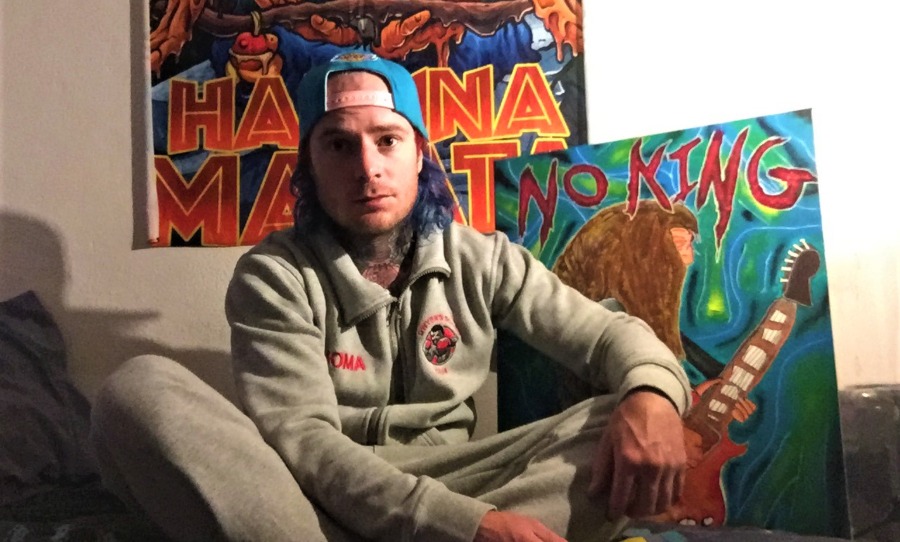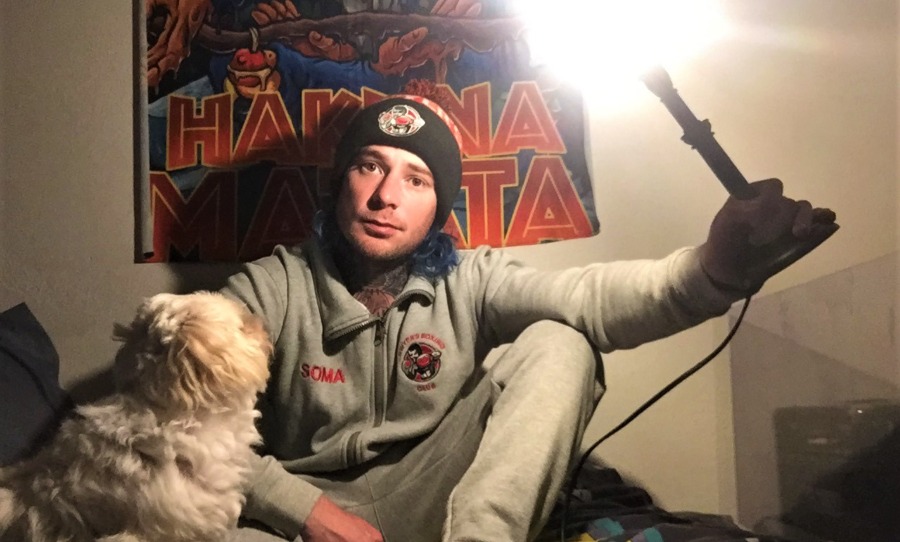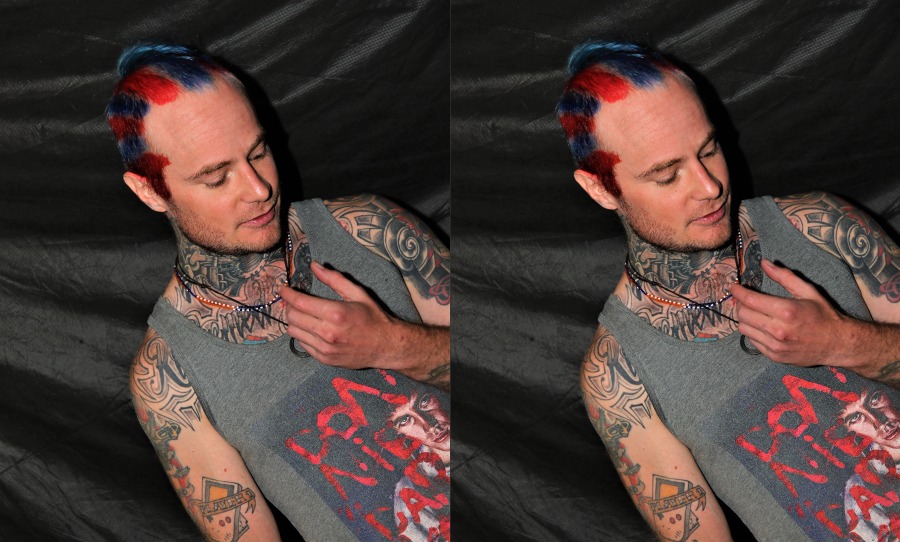Fresh off an exclusive tour of his makeshift creative studio space, we caught up with Soma In Motion for a chat about art philosophy and “the relentless pursuit of money.”
Earlier this month, South Australian creative Soma In Motion led Happy Mag on a guided tour through his Mount Gambier studio space. Described by the musician — known offstage as Tyson Jay Brant — as a “sanctuary and gallery,” the eclectic studio is the birthplace of Soma In Motion’s new single Subject V Object, as well as a breeding ground for his numerous ventures into animation, philosophy and everything in between. “In art being yourself is not only encouraged, it’s essential,” Soma told us of his broad creative muses.
Drawing influence from the likes of Willy Wonka, writer James Joyce, and Berlin’s underground scene, Subject V Object is an electronica-infused rumination on “how I see things,” Soma said in an exclusive interview with Happy Mag. Below, we catch up with the Mount Gambier musician for a chat on all things creating, festivals, and his music’s message around “the relentless pursuit of [money].” Scroll down for our complete interview with Soma In Motion, and head here to listen to his new single, Subject V Object.

HAPPY: What are you up to today?
SOMA: Just finished up doing a little labouring work for a local tree removal company. Went for my daily run around Mt. Gambier’s blue lake. Maybe I’m gonna play a little nintendo and do a little sketching while I wait for some new music equipment to arrive from ebay.
HAPPY: Tell us about your average day.
SOMA: I usually start off with some breathing exercises and a cold shower before I head off to work. I like to bounce between different labour intensive jobs. It’s a great way to stay fit and it’s basically like getting paid to train. I live alone with my rabbit and guinea pig and my daughter stays with me on the weekends. So I mostly like to stay busy whether that’s training, painting or making music, and if I feel like Iv’e earned it I’ll chill and play some video games. Then maybe I’ll get a little reading in and meditate before I catch some z’s
HAPPY: What about your ultimate day?
SOMA: Well I love going to festivals. If I get to see someone I’ve been hanging out to see then that usually does it for me. I’ll be hitting up the “world is a vampire tour” in a couple of weeks to see Smashing Pumpkins and Jane’s Addiction, so that’ll probably be a strong contender. Perry Farrell is the man.
HAPPY: Tell us about your creative community.
SOMA: They’ve been super supportive, and it’s growing every day. We’ve produced some great talent like Higsfield and Chelsea Manor who play the Lucidale one night stand and recently performed with Fidlar, who I love. The Riddoch Culture and Arts Centre is great and it’s centred right in the middle of town which is nice. There’s a really strong music scene and it’s awesome to be a part of it.

HAPPY: What did you read or watch last that opened your eyes and mind to a new perspective?
SOMA: I recently read James Joyce’s The Portrait of the Artist as a Young Man. I’m not one for politics and it seemed to me in this day and age people kind of demand you take a side. Sitting on the fence may be a little precarious at times but at least you get a good view of what’s going on, on either side. Joyce kind of toed that same line, so it was a bit of a relief to know I wasn’t the only one. Mad God by Phill Tippets was a good one too. His animation style and uncompromising attitude towards filmmaking is very admirable.
HAPPY: Can you tell us more about the concept behind Subject v Object and how it reflects your personal philosophy and artistic influences?
SOMA: Really, Subject V Object was my interpretation of how I saw things. I feel like people grind away earning money to go to work to earn money to buy things in order to help them handle the grindstone. Which is fine but I just couldn’t see myself getting old and thinking “jeez this is it huh?” You can’t take that money when you go. Also I think money has been an incredibly corrupting force in today’s society, well…. not so much money but the relentless pursuit of it anyway. Wealth is great if it’s in the hands of someone who knows what to do with it. But nah, I’m happy with my two bedroom apartment and my pets and fam.

HAPPY: The use of samples in the song adds a sense of theatricality and drama. Can you talk about how you choose and incorporate these samples into your music?
SOMA: Not much to say there. I just think it sounds awesome and the visual medium of film I think can trigger an emotional response to the people who have seen those films. Basically I think they can say something a lot louder and clearer than I could with cryptic lyrics or existential angst.
HAPPY: What role does analog gear play in your recording and mixing process, and do you have any favourite pieces?
SOMA: I’m very much a minimalist when it comes to that sort of thing. I’m not very tech savy. I don’t think I could even tell you the difference between analogue and digital equipment. I started as a bass player in a punk band called rehashed. We played punk covers from bands like NOFX and sex pistols. I learned to play by ear so I would learn all the songs by just listening to them, so I have a good ear. If it sounds good to me then it makes sense.
HAPPY: Which gear do you rely on?
SOMA: In today’s day and age it’s so easy to just grab a free DAW and a midi keyboard and if you have the patience and will, you can pretty much come up with anything. A cheap mic, usb interface, 100$ midi keyboard and you got yourself a pretty sturdy little springboard.
HAPPY: The visuals that accompany the song are striking and haunting. Can you talk about the inspiration behind the imagery and how it relates to the themes in the song?
SOMA: It’s all about shadow integration. Tool was a big inspiration as well as the philosophy of Carl Jung. It doesn’t necessarily mean anything. I usually just lay on my bed and wait and whatever comes out I try to illustrate the best way I can. It’s therapy more than anything else.
HAPPY: You cite a range of influences, from philosophers to pop culture animation. How do you approach blending these influences together to create a cohesive sound and visual aesthetic?
SOMA: I try not to think about it. Tim Minchin had a cool line “It’s alright to be influenced, just not consciously influenced.” It’s more a feeling than it is an intentional blending of ideas.
HAPPY: Your music is often described as challenging and thought-provoking. What do you hope listeners take away from your music, and how do you hope to impact the wider music industry with your unique sound?
SOMA: Do it for yourself. If you do it for anyone else it won’t register. I think people can pick up on that in a way we don’t entirely understand, and we’re not supposed to. If you’re someone who struggles to find answers, someday you’ll more than likely discover you have no choice but to come up with your own, even if that means going through life with your fingers in your ears going LALALALALA hahaha.
HAPPY: Most importantly, what makes you happy?
SOMA: The finished product of something I’ve been working on. The process can be draining at times, but when it’s done I breathe a sigh of relief and have that little fleeting sense of contentment. Performing is great too, even though it can be nerve racking at times, it’s a great way to challenge yourself, which is really the only way you grow.
